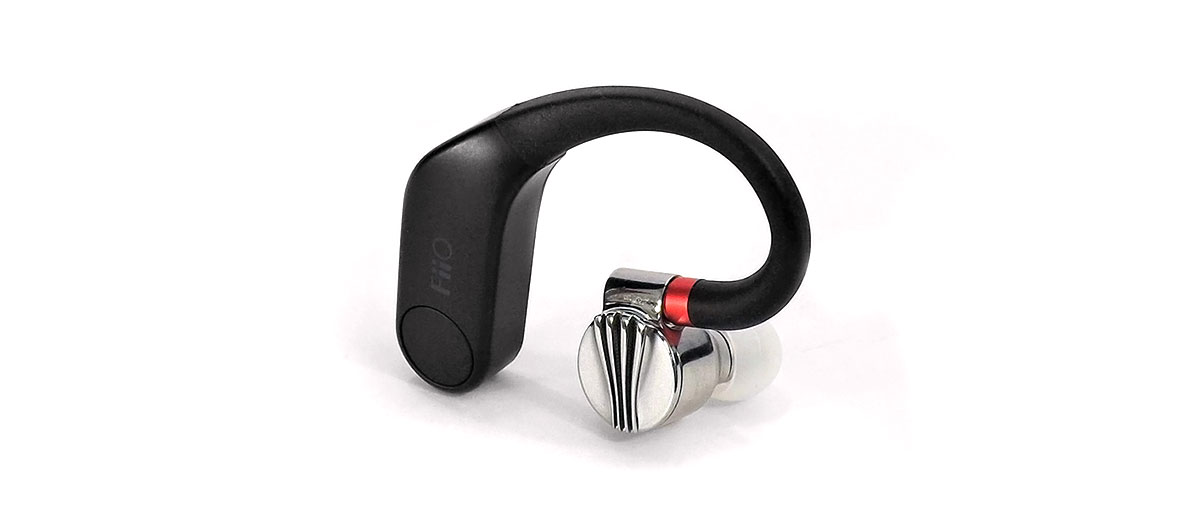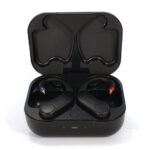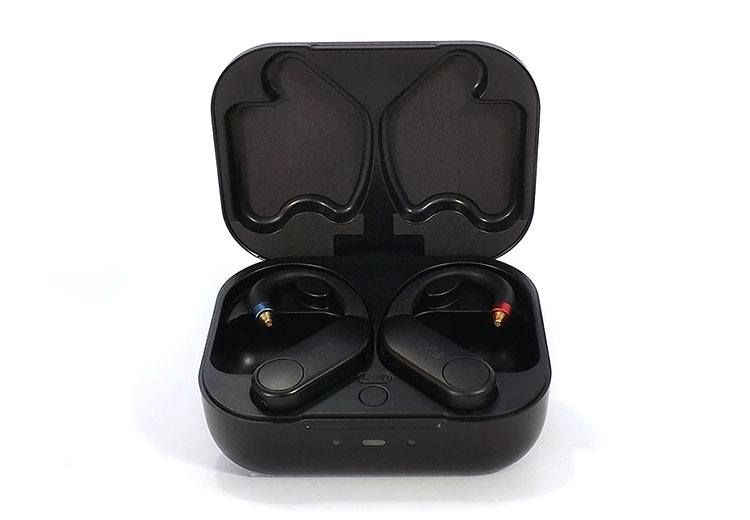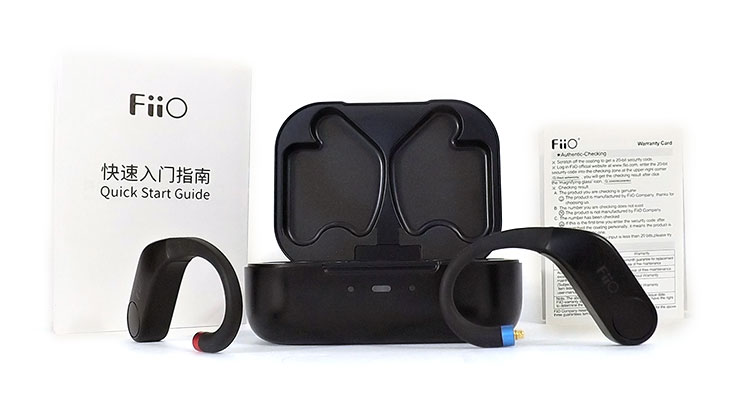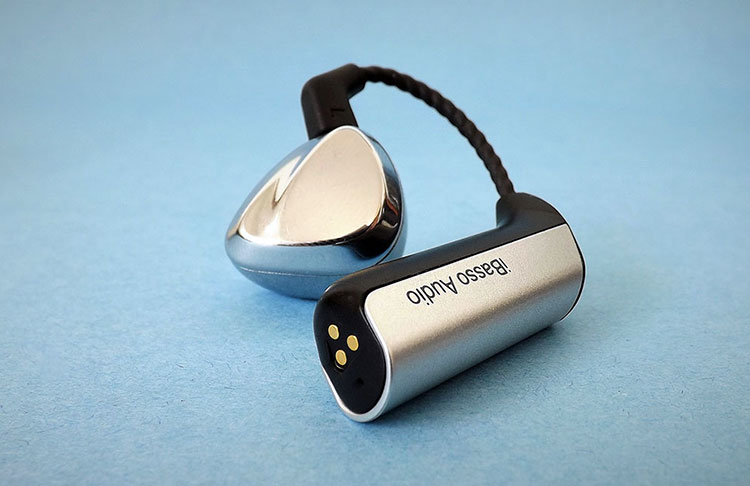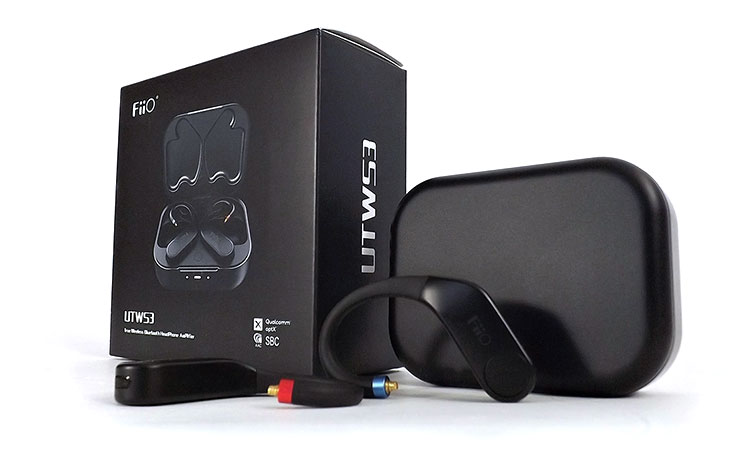The FiiO UTWS3 is a detachable BT amplifier and dongle for your existing earphones in the style of a TWS with BT5.0, aptX, and up to 30 hours of battery life. It is priced at $79.99
Disclaimer: The FiiO UTWS3 sent to us is a sample in exchange for our honest opinion in this review. We thank FiiO for this opportunity.
To learn more about FiiO reviews on Headfonics you can click here.
Note, this review follows our new scoring guidelines for 2021 which you can read up on here.
FiiO is one of the companies that are responsible for my headphone audio hobby taking off. My first quality DAC amplifier was the FiiO E10. Not the K variant but the first model. I even bought their E6 which I thought was very innovative because of its size and capabilities.
Times have changed and new technologies have been introduced and it is nice to see FiiO still constantly introducing their own. It keeps the hobby interesting and competitive amongst manufacturers.
One of those innovations is in the TWS segment that has bought us the freedom of going wireless and FiiO, of course, has also entered this segment.
We recently received the FiiO UTWS3 for review. The UTWS3 is a follow up of their UTWS1 and the U is the clue of what these do because what we have here is a Universal TWS dongle that can be used to turn any earbud you can buy or own with an MMCX connector and go completely wireless.
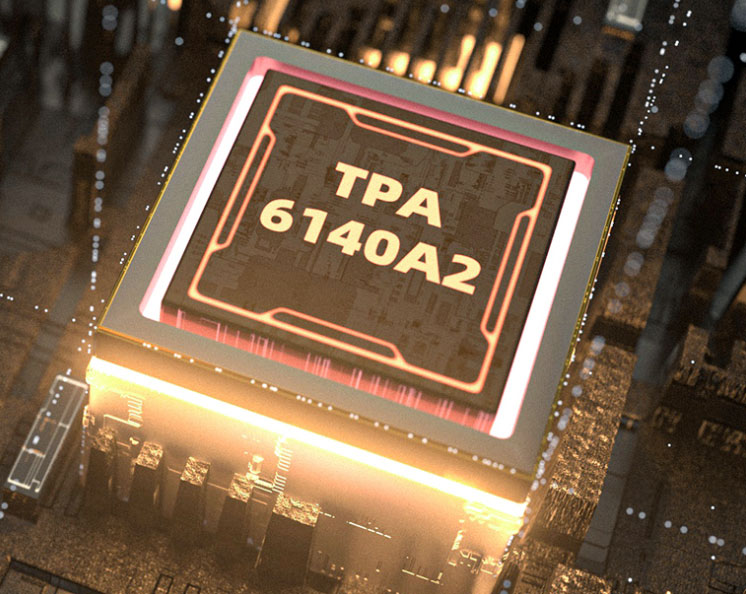
Tech Inside
The FiiO UTWS3 is a universal Bluetooth 5.0 TWS dongle set with a one-chip solution that looks a little similar to the UTWS1 except for a couple of obvious visual cues.
There are some technical differences between the UTWS1 and the UTWS3 and one of the few on that list is that the UTWS3 has an app available with lots of features including OTA firmware upgrades.
Another difference is that the FiiO UTWS3 has a separate TPA6140A2 amplifier chip that boosts the power output of the internal Qualcomm chip from the normal 14mw at 16Ω and more than doubles it to 38mw at the same load.
QCC3020
The FiiO UTWS3 uses the commonly used Qualcomm QCC3020 BT chip for all the basic functions but with a twist which is the additional amplifier chip.
So what we have here is a QCC3020 with more than double the power output of other similarly equipped TWS models out there and because of the inclusion of the separate amplifier chip, it helps obtain a higher level of fidelity.
Not only is there more power available compared to the UTWS1 but the noise floor was also lowered from 25uV to 8uV which translates to just one-third of the noise level present on the UTWS1.
On top of that, the signal-to-noise ratio was also improved taking the UTWS3 SNR from the 88dB rating of the UTWS1 to a higher 100dB rating.

CVC Noise Canceling
Here is another addition to the list of added features the FiiO UTWS3 has over their first version, the UTWS1 which has a single microphone system.
The UTWS3 has a dual CVC noise-canceling microphone system in each dongle that uses one to sample ambient noise to then counteract noise to clean up vocal clarity.
The quality was similar to my phone in tone and although the UTWS3 has dual microphones the system works in mono but does work well with no complaints of people not understanding my speech so far.
I also used the UTWS3 in voice chat rooms in Discord and everyone understood me perfectly and even got some compliments on clarity.
IPX4
Waterproofing is essential in a device like the FiiO UTWS3 and they do have a rating of IPX4 so in case someone sprays you accidentally, or purposely, with a garden hose they will be fine.
It is safe to say these are good for workouts and physical activity because during the time I used them they never fell off or felt uncomfortable enough to have to take them off prematurely if I wore them for long periods.
Codec Support
The Fiio UTWS3 has a decent set of codecs available starting with aptX along with ACC and SBC.
I did a latency test using aptX and I got the aptX average of 0.2 seconds of delay which is acceptable. My phone and PC mostly ran the UTWS3 with aptX on Android 10 and Windows 10. The latency test was done on a PC.
I personally did not run into any trouble with compatibility or issues with pairing this device and it’s nice to see aptX back on a device after reviewing a few other BT devices that excluded this codec even though they had a higher price tag.
Design
The FiiO UTWS3 charging case is made mostly of plastic and so are each of the dongles. I was surprised to find that the door has a metal lining which is a nice touch and unseen at this price from other TWS models.
The quality seems good and everything seems to be easy to clean and keep clean except for the rubber-coated ear loops which like to cling to dust and lint. The rubber coatings inside the case meant to protect the IEMs are minimum and since the case is closed most of the time the interior keeps clean.
The case can also hold the dongles with the IEMs attached which is a good feature but does increase the case size obviously.
Dongles
The FiiO UTWS3 dongles are light and comfortable. The ear loops themselves have some memory wire inside and have some flexibility and are very comfortable once the loops form themselves around the ears.
Monocrystalline silver plated wire is used from the internal components to the MMCX connectors which according to FiiO enhances connectivity and improves fidelity.
Each MMCX connector has a color-coded band to indicate left and right easily. They seem good quality because they resist spinning.
Controls
The FiiO UTWS3 uses push buttons that are so light to operate they may as well be classed as touch controls. They only require 60 grams of force to operate, however, they do seem to retain a good tactical feel when pressed.
Here lies another difference between the UTWS3 and the UTWS1 in where the UTWS1 has a visually smaller button layout making the UTWS3 buttons easier to operate.
Operation is common with the usual press once, twice, or 3 times and there is Haptic control with a hold feature that advances or plays the previous track. You can also change the button functions within the app. I found them to be fairly intuitive but if you do not then you could customize their functions which is a nice touch.
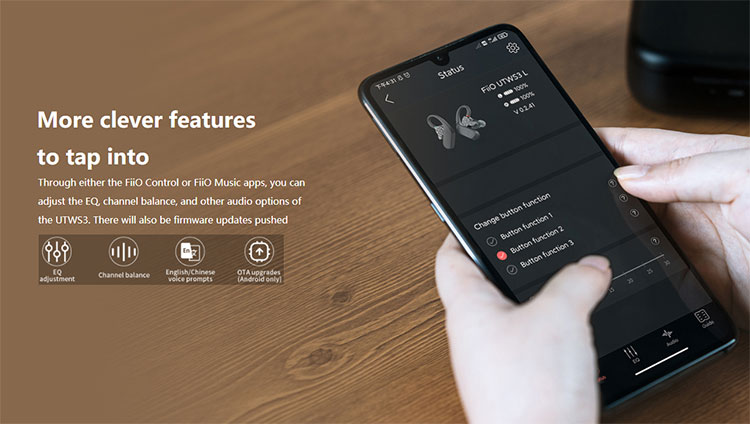
FiiO Control
The FiiO UTWS3 also pairs through their FiiO Control app that you can download for free and it does have a lot of useful features. FiiO also makes available a music player app that is getting good reviews over at the Android Playstore.
The app has a 5-band EQ with 3 presets, a channel balance adjustment plus OTA firmware upgrades but the updates can only be done on Android devices for now.
The app does have some quirks but FiiO promises to push updates and firmware improvements so perhaps the app will get better later on but regardless presently it has plenty of features.
There is a voice prompt system that is switchable between English or Chinese. I thought this was a cool feature. Remember always to thank the lady at the prompt. Lots of other features are available so check out the app and as always, read the manual.
Charging Case
The FiiO UTWS3 charging case has an 800mAh battery and has enough power to supply around 30 hours of playback charge time with 4 to 5 full charges for both dongles.
The charging case has a multifunction pushbutton inside that is pushed to put in pairing mode and also interfaces with the charging LEDs to let you know how much charge is available.
One small drawback the FiiO UTWS3 has against the UTWS1 is that battery life went from 8 hours on a single charge down to 7 hours but I consider it a good trade-off for the improved sound. I would expect that with the additional amplifier chip.
To be honest I got around 6 hours of battery life which is still acceptable and beyond what most TWS can obtain. I mostly used a single dynamic driver IEM with music and at 60% volume.
Sound Impressions
First off I must warn people because the FiiO UTWS3 came at 100% volume from the factory and when I first paired it with my PC it also assumed the device should get full volume at the PC volume level.
Long story short, the first time I heard these were with a blast at full volume and these can get quite loud. It scared the daylights out of me so make sure to turn the volume down before engaging that play button.
Summary
That said, I was pleasantly surprised to find a flat tonality with a decent amount of power behind it compared to a similarly equipped QCC3020 device.
Low frequencies were produced well and although the high frequencies did not extend far the sound was balanced in general especially in the midrange area.
I could mention 20 devices with the QCC3020 and all have a bloated bass response but these seem to have a flat bass response. It is a touch on the dry side but in quality and quantity, it satisfies.
There seems to be a good amount of dynamic range as well and the addition of the TPA6140A2 amplifier chip shows good results in this area.
The midrange response was smooth and no anomalies were present in the listening tests or the tone sweep test. These performed very well in the midrange.
On the top end of things, everything seems to be reproduced fairly sharp but when I ran the tone sweep test they refused to go beyond 14khz which I find is a common trait with the QCC3020 chip in other models as well.
Funny thing is that this trait does not seem to affect the quality of the high frequencies much and they seem cleaner and sharper compared to similarly equipped TWS models. They seem to extend better than what the test indicated.
Pairing Synergy
I mostly paired the FiiO UTWS3 with the new FiiO FD5 which is a single dynamic driver IEM that is very efficient and the combination seemed like a perfect match. The sound quality was way beyond most TWS models available I have reviewed or heard.
I also tried several other IEMs including some hybrid multi-driver models and they all seem to play well with the FiiO UTWS3 with plenty of volume to spare. If they are fairly efficient IEMs and have an MMCX connector, the FiiO UTWS3 will push it.
Wireless Performance
Pairing
I was somewhat confused initially pairing the FiiO UTWS3 because it shows up as two separate devices and one is marked left and the other right. Then I had a moment of clarity and realized these can be paired individually and are equipped with TWS+ dual transmission.
The benefit is easier individual pairing and the elimination of the master and slave system of the past which depletes the battery on one side before the other. The only drawback is as you raise the volume, the sound pans left to right in every one of the 26 steps of volume which sounds weird and somewhat disorienting to me.
Remember to initially pair by using the button on the charging case. This system is somewhat uncommon but it works well. Once the initial pairing is done all you have to do is open the case door and the dongles will connect and they also remain connected until you sit them back in the case and close the case.
Range & Stability
Once connected to my device, I got around 37 feet of distance in a straight visible line before the signal started to drop. This is above average for a QCC3020 and it seems FiiO squeezed the maximum performance out of this chip in that respect.
Selective Comparison
iBasso CF01
The recently reviewed iBasso CF01 was my first TWS dongle and it was a good one particularly because all other previous models had a terrible noise floor in the form of hiss and the CF01 was almost free from hissing. I think the inclusion of a separate amplifier chip is responsible for that.
The only caveat here is the higher price but the quality shows especially in the construction of the dongles. FiiO steps forward with the inclusion of the additional amplifier chip like iBasso did but at a reduced price.
Design
The iBasso CF01 has an upscaled design including metal laminates on the dongles that give it an expensive appearance. Quality color coded MMCX connectors were also used with a tight fit that also resists spinning.
The iBasso CF01 has a better form of protecting the IEMs inside the case with a rubber air sack system and the UTWS3 only has rubber laminates. Other than that, They both seem to be similar in size and weight.
I did like the button and functions more so on the UTWS3 and the inclusion of an app is nice to have.
Performance
The iBasso CF01 and the UTWS3 have similar tonality and seem to be equal in that respect and is probably due to both using the same QCC3020 chip and both having a separate amplifier chip.
They both seem to aim for a tonality that is flat and balanced in frequency response. Both keep hiss to a minimum but the UTWS3 seems to be the more powerful of the two.
Our Verdict
By the inclusion of a separate amplifier chip, the FiiO UTWS3 has taken the lead in my opinion, especially at the asking price. I was surprised at the increase in sound quality which reveals itself once you hear them compared to other QCC3020 devices.
The touch controls work very well with reassignable functions within the app if they are not intuitive enough for you plus many other features.
The FiiO UTWS3 should be considered for purchase if you need a Bluetooth dongle for your MMCX equipped IEMs.
FiiO UTWS3 Specifications
- Output Power 38mW(16Ωload)25mW(32Ωload)
- Noise<8μV
- Driveability 16~100Ω
- THD+N<0.06%
- SNR 100dBr “A“
- Working Time TWS+: 7hs of use each charge, TWS: 5.5hs of use each charge
- Overall battery life 30h (4-5 times recharge from the case)
- Output Impedance about 0.7Ω
- Crosstalk 94dB
- Balance ≤0.5dB
- DimensionsL 93.5 x 71.1 x 34.6
- Weight 125.5g

